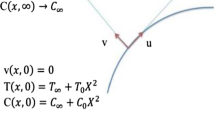Abstract
Marangoni convection arises when the surface tension of the fluid varies spatially due to accompanying temperature gradients along the interface, which can occur in various ways. In the case of nonuniform surface heat fluxes imposed due to incident beams from power sources, Marangoni convection can be induced within heated liquid pools formed during melting in a number of material-processing applications. In this work, we develop a physical model and study the thermocapillary flow generated due to an imposed surface heat flux with a specified spatial variation. Furthermore, we incorporate the effect of applying a magnetic field to investigate its influence on the structure of such unique class of surface tension-driven flows. New similarity solutions are developed for the thermocapillary convection due to an imposed interfacial heat flux variation specified as \(\mathop q\nolimits _0 \mathop x\nolimits ^{n + 1} \), where x is the surface coordinate and \( \mathop q\nolimits _0 \) is a parameter representing the magnitude of the incident power. Numerical results are obtained and the structure of the Marangoni convection for various sets of the characteristic parameters, such as the power-law exponent n, Prandtl number Pr and a magnetic interaction parameter M, are studied. In particular, it is found that with the increasing n, i.e., considering sharper variations in the surface heat flux profiles, the Marangoni convection is promoted. Conversely, with the increasing M, the magnitudes of the thermocapillary convection velocity are decreased, thereby demonstrating the damping effect of the magnetic field.
















Similar content being viewed by others
References
Napolitano LG (1978) Microgravity fluid dynamics. In: 2nd Levich Conference. Washington, DC
Napolitano LG (1982) Surface and buoyancy driven free convection. Acta Astronaut 9:199–215
Napolitano LG, Russo G (1984) Similar axially symmetric Marangoni boundary layers. Acta Astronaut 11:189–198
Arafune K, Hirata A (1998) Interactive solutal and thermal Marangoni convection in a rectangular open boat. Numer Heat Transf Part A 34:421–429
Banks WH, Zaturska MB (1986) Eigensolutions in boundary layer flow adjacent to a stretching wall. IMA J Appl Math 36:263–273
Slavtchev S, Miladinova S (1998) Thermocapillary flow in a liquid layer at minimum in surface tension. Acta Mech 127:209–224
Arafune K, Hirata A (1999) Thermal and solutal Marangoni convection In-Ga-Sb system. J Cryst Growth 197:811–817
Schwabe D, Metzger J (1989) Coupling and separation of buoyant and thermocapillary convection. J Cryst Growth 97:23–33
Christopher DM, Wang BX (2001) Prandtl number effects for Marangoni convection over a flat surface. Int J Therm Sci 40:564–570
Christopher DM, Wang BX (2001) Similarity solution for Marangoni convection around a vapor bubble during nucleation and growth. Int J Heat Mass Transf 44:799–810
Christopher DM, Wang BX (2002) Similarity solution for Marangoni convection over a flat surface. J Heat Transf 124:587–589
Pop I, Postelnicu A, Grosan T (2001) Thermosolutal Marangoni forced convection boundary layers. Meccanica 36:555–571
Magyari E, Chamkha AJ (2007) Exact analytical solutions for thermosolutal Marangoni convection in the presence of heat and mass generation or consumption. Int J Therm Sci 43:965–974
Lin Y, Zheng L, Zhang X, Muller G (2013) Magnetohydrodynamic thermocapillary Marangoni convection heat transfer of power-law fluids driven by temperature gradient. J Heat Transf 135:051702–6
Jiao C, Zheng L, Lin Y, Ma L (2016) Marangoni abnormal convection heat transfer of power-law fluid driven by temperature gradient in porous medium with heat generation. Int J Heat Mass Transf 92:700–707
Mat NA, Arifin NM, Nazar R, Ismail F, Pop I (2013) Radiation effects on Marangoni convection boundary layer over a permeable surface. Meccanica 48:83–89
Lin Y, Zheng L, Zhang X (2014) Radiation effects on Marangoni convection flow and heat transfer in pseudo-plastic non-Newtonian nanofluids with variable thermal conductivity. Int J Heat Mass Transf 77:708–716
Hainke M, Friedrich J, Vizman D, Muller G (2003) MHD effects in semiconductor crystal growth and alloy solidification. In: Proceedings of the International Scientific Colloquim, Modelling for Electromagnetic Processing, pp 73–78
Witkowski LM, Walker JS (2001) Flow driven by Marangoni convection and rotating magnetic field in a floating-zone configuration. Magnetohydrodynamics 37:112–118
Al-Mudhaf A, Chamkha AJ (2005) Similarity solutions for MHD thermosolutal Marangoni convection over a flat surface in the presence of heat generation or absorption effects. Heat Mass Transf 42:122–121
Magyari E, Chamkha AJ (2008) Exact analytical results for the thermosolutal MHD Marangoni boundary layers. Heat Mass Transf 47:848–857
Debroy T, David SA (1995) Physical processes in fusion welding. Rev. Mod. Phys 67:85–115
Chan CL, Chen MM, Mazumder J (1988) Asymptotic solution for thermocapillary flow at high and low Prandtl numbers due to concentrated surface heating. J Heat Transf 110:140–146
Pumir A, Blumenfeld L (1996) Heat transport in a liquid layer locally heated on its free surface. Phys. Rev. E 54:R4528–R4531
Karlov SP, Kazenin DA, Myznikova BI, Wertgeim II (2005) Experimental and numerical study of the Marangoni convection due to localized laser heating. J Non-Equilib Thermodyn 30:283–304
Thess A, Boos W (1999) A model for Marangoni drying. Phys Fluids 11(12):3852–3855
Matar OK, Craster RV (2001) Models for Marangoni drying. Phys Fluids 13(7):1869–1883
Prange M, Wanschura M, Kuhlmann HC, Rath HJ (1999) Linear stability of thermocapillary convection in cylindrical liquid bridges under axial magnetic fields. J Fluid Mech 394(1):281–302
Huang Y, Houchens BC (2011) Numerical modeling of thermocapillary driven liquid bridge with magnetic stabilization. J Mech Mater Struct 6(7–8):995–1061
Author information
Authors and Affiliations
Corresponding author
Rights and permissions
About this article
Cite this article
Hajabdollahi, F., Premnath, K.N. Thermocapillary convection due to imposed interfacial heating in the presence of magnetic field. J Eng Math 108, 37–52 (2018). https://doi.org/10.1007/s10665-017-9903-0
Received:
Accepted:
Published:
Issue Date:
DOI: https://doi.org/10.1007/s10665-017-9903-0



